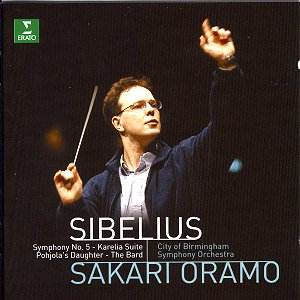 |
Jean SIBELIUS (1865-1957) Crotchet
AmazonUK
AmazonUS |
The Sibelius 5 that the CBSO and Oramo gave at the Proms on 19 August suggested an interpretation in the making; not quite ready for the studio I mused. As you can see, this recording was actually done and dusted a few months before the rather hasty Royal Albert Hall account.
Oramo is, the grapevine suggests, quite a taskmaster in rehearsal. The music-making that he and the CBSO have given us so far on CD - Grieg, and the first instalment of their Sibelius cycle (Symphonies 2 and 4) - has been hallmarked by spontaneity. Oramo, of course, has had to follow in Simon Rattle's footsteps; Rattle devoted much time to Sibelius during his tenure, including a recorded survey for EMI. It says much for Oramo's abilities and personality that he has put his own, distinctive viewpoint on this music after only a season or two as the CBSO's Music Director.
I've now listened to Oramo's Sibelius 5 several times - with increasing enjoyment and admiration. His is an elemental view, one not so much hasty as urgent; there's always a feeling of going somewhere, and the need to get there is imperative. Perhaps Oramo sells the music a little short on atmosphere, and if, just occasionally, the Orchestra sounds a tad hesitant or uncertain, then I think it has to do with meeting Oramo's demands, and what appears to be unedited takes that do not disguise the occasional glitch.
Ironically, it's Oramo himself that threatens Sibelius's iron-grip construction. The very opening doesn't so much start as materialise, the horn call has surely already been playing when we become aware of it. Oramo is already pushing ahead, although there's plenty of plangent expression from the winds, and anticipation in the strings' tremolos. Oramo's increase in pace at 2'16" is initially disconcerting, yet convinces more when the trumpet tune enters at 2'36". Oramo has set his stall out, and for all the pushing ahead, there's a great deal of care with phrases, punctuation and dynamics. Nor does Oramo underestimate the symphony's solitary aspects - the lonely bassoon over sotto voce strings (from 5'22") is particularly compelling, especially in the amount of detail Oramo secures. The great climb that signals the emergence of the scherzo is at first monumental, then a fall forward; the emerging 'Presto' is certainly fleet - and it should be remembered that 'poco a poco stretto' instructs an increase of speed into this new but related section; Oramo drives the music on until the dam bursts with thrilling inevitability.
Oramo's judgement on the second movement is to underline the 'Allegretto' part of the indication; to good effect. It's easy for this movement to drag, which Oramo avoids by effecting a gentle dance; firm pizzicati offer tautness under the woodwinds' languor, which becomes hypnotic until tensions break the spell. The finale is less headlong than might have been supposed, the swinging hymn-like idea (from 1'44") is integrated into the whole - Oramo knows the true apotheosis is still to come. When that moment is signalled (at 5'30") he backtracks on tempo to build the closing peroration with epic grandeur, CBSO brass in fine form. Prior to that, there's a wonderful example of hushed strings playing at speed (3'48"-4'51"), wonderfully captured by the recording. Also well recorded are the double basses, so important as the music's fundament.
A few moments of opacity aside, the sound quality is spacious and detailed with plenty of power. The remaining items are all successful, although I find Pohjola's Daughter - a great tone poem - a little lacking in mystery and poise, the flare-up between 6'23"-7'45" can't compete with, say, Bernstein's New York drama and instrumental clarity. Karelia enjoys a moderate tempo in the opening 'Intermezzo', an unindulged 'Ballade', which makes the solemn middle section (from 3'05") all the more telling, and a perky 'Alla marcia'. The Bard, a desolate landscape conjured by sparse orchestration, the harp offering flecks of colour, is another remarkable example of Sibelius enthralling the listener by almost minimalist means (and none of the minimalists can hold a candle to him!). Oramo has its measure, its orchestral half-lights - this is a conductor who relishes his players retreating to an inner world of sound - and when the bard himself strains for one final oration he does so with a Tchaikovskian passion (not sure though about the edge to the brass, 6'18"-6'38", which is no doubt intentional and perhaps justified programmatically).
Despite a few doubts, this is a moreish CD. What stands out is Oramo's ability to breathe new life into familiar music, a quality not be underestimated; hand-in-hand with this welcome freshness is a deeply considered view of the music that indicates this CD that will be off the shelf regularly.
Colin Anderson